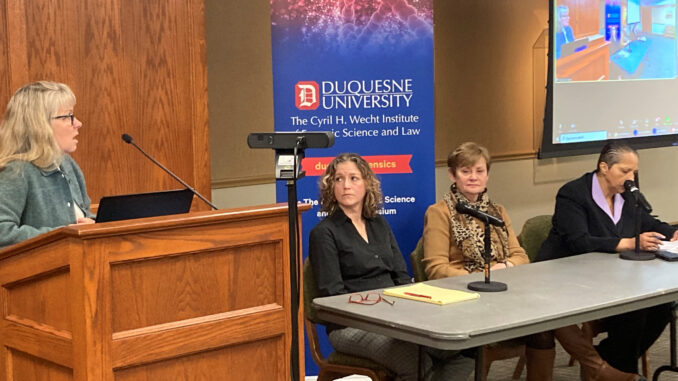
Josh DeLia | Staff Writer
Feb. 09, 2023
Racial inequality is widespread in crime coverage and in the true crime genre, media professionals said at an on-campus seminar Friday.
The event, “Missing White Woman Syndrome” was hosted by Duquesne’s Cyril H. Wecht Institute of Forensic Science and Law, and co-sponsored by the Institute for Ethics and Integrity in Journalism. The event was attended by visitors in-person and online, for a total of about 50.
Margaret Jones Patterson, a professor of journalism at the university, talked about how society has created a “perfect victim.”
This victim in crime coverage is described as being young, pretty, slim, middle class, blue-eyed and blonde, “despite an increasing acceptance of a diversity of beautiful faces and diversity of body types,” Patterson said.
“To understand and grapple with the huge, huge problem of violence in America, we need to hear the stories of black women and indigenous women and the great majority of women because no real-life woman is a Barbie doll,” she said.
Patterson also explained that many crime reports glorify the victims of violence in a straightforward, good-versus-evil story with victims painted as completely innocent and perpetrators labeled as heinous.
Jean Murley, a professor of English at Savannah College of Art and Design, shared her observation of media coverage concerning racially diverse victims. Murley specializes in the true crime genre in media.
While the genre, which primarily focused on white victims historically, is still flawed, positive progress has been made toward more diverse racial representation, Murley said.
“True crime now is much more responsive to these issues, and there are many more podcasts devoted to black victims, devoted to missing and murdered indigenous women, devoted to the cases that in an earlier media landscape, were not getting any attention,” she said.
Murley used an example of a woman of color from Crown Heights, Brooklyn, who was thrown off a rooftop, later to be found dead in an air shaft, resulting only in “an inch of coverage” in a single newspaper.
She compared this to the Central Park Five case, which saw a group of young men of color wrongly convicted for raping and leaving a white woman for dead in 1989, with the original story reaching national coverage.
Murley expressed her disappointment in how quickly upper and middle-class crime stories gain enormous media attention compared to lower class ones.
“What has traction is when there’s beautiful people murdering each other, essentially,” she said.
Paula Reed Ward, a reporter for the Pittsburgh Tribune Review and faculty advisor for The Duke, also spoke about discrimination in journalistic media at the panel.
Ward remembered there being unfair criteria for what was worthy of being front-page news during her time at the Savannah Morning News.
She noticed that many homicide cases were not considered to be front-page material unless they involved middle- or upper-class white women.
“I found that discrepancy to be pretty disturbing. I didn’t like that there was that inequity among the coverage,” Ward said.
Ward had a meeting with her editors and was able to convince them to change the policy so that any homicide going forward would be put on the front page.
While race has been a factor that has influenced crime coverage, there are others at play as well, she said.
It also depends on where the crime has occurred, the victim’s socio-economic status, whether the family is media savvy, what resources they have, the general details of each crime and the relationship between the media and the police, she said.
Peg Bittner, 70, a frequent guest of Institute of Forensic Science and Law programs, was one of about 8 in-person attendees present for the seminar, and she thoroughly enjoyed the discussions.
“I learned so much that it’s going to take some time to get it digested,” she said.
Patterson believes media consumers need to read news stories as citizens and view those involved as people shaped by our shared communities.
“Crime victims are rarely perfect, but each has a story to tell, and they don’t deserve to be ignored because they fall outside some artificial standard of beauty,” she said.

